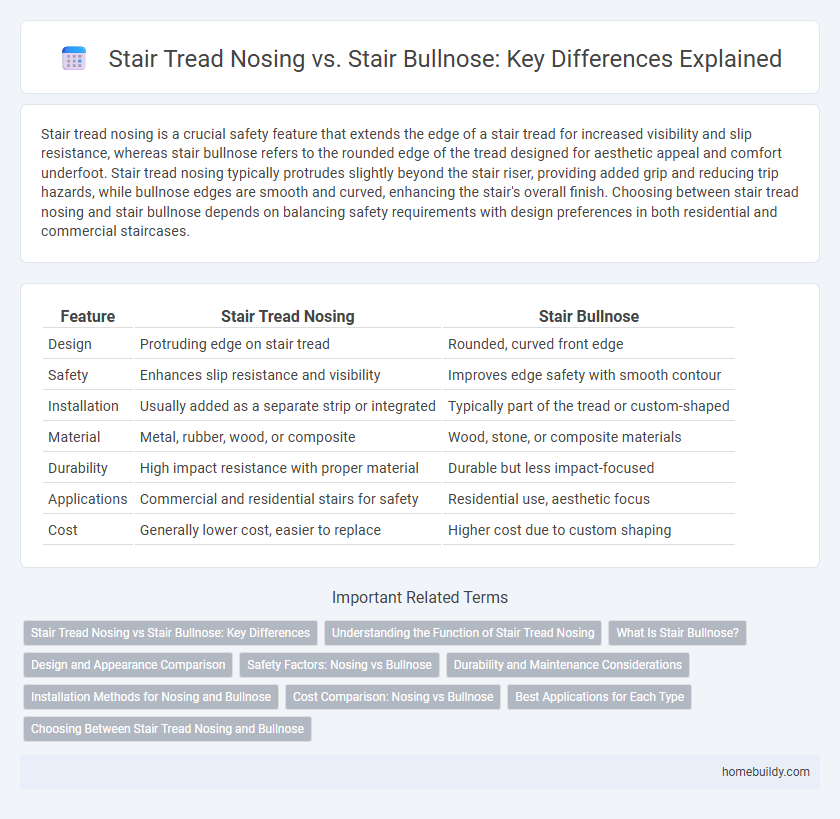Stair tread nosing is a crucial safety feature that extends the edge of a stair tread for increased visibility and slip resistance, whereas stair bullnose refers to the rounded edge of the tread designed for aesthetic appeal and comfort underfoot. Stair tread nosing typically protrudes slightly beyond the stair riser, providing added grip and reducing trip hazards, while bullnose edges are smooth and curved, enhancing the stair's overall finish. Choosing between stair tread nosing and stair bullnose depends on balancing safety requirements with design preferences in both residential and commercial staircases.
Table of Comparison
| Feature | Stair Tread Nosing | Stair Bullnose |
|---|---|---|
| Design | Protruding edge on stair tread | Rounded, curved front edge |
| Safety | Enhances slip resistance and visibility | Improves edge safety with smooth contour |
| Installation | Usually added as a separate strip or integrated | Typically part of the tread or custom-shaped |
| Material | Metal, rubber, wood, or composite | Wood, stone, or composite materials |
| Durability | High impact resistance with proper material | Durable but less impact-focused |
| Applications | Commercial and residential stairs for safety | Residential use, aesthetic focus |
| Cost | Generally lower cost, easier to replace | Higher cost due to custom shaping |
Stair Tread Nosing vs Stair Bullnose: Key Differences
Stair tread nosing extends slightly beyond the stair tread, providing enhanced grip and increased safety by reducing slip hazards, while stair bullnose features a rounded edge integrated into the tread's surface for aesthetic appeal and comfort. Nosing typically highlights functional safety compliance in commercial or high-traffic areas, whereas bullnose design emphasizes smooth transitions and visual softness in residential or architectural staircases. Material choices for nosing often include anti-slip finishes like aluminum or rubber, contrasting with bullnose's predominant use of wood or stone for seamless edging.
Understanding the Function of Stair Tread Nosing
Stair tread nosing enhances safety by providing a visible, slip-resistant edge that extends beyond the stair riser, reducing the risk of slips and falls. Unlike stair bullnose, which features a rounded edge primarily for aesthetic appeal, tread nosing is specifically designed to improve traction and durability on high-traffic staircases. Proper installation of stair tread nosing complies with building codes and significantly increases stair longevity and user safety.
What Is Stair Bullnose?
Stair bullnose refers to a rounded edge detail on stair treads that creates a smooth, curved transition between the tread and riser, enhancing safety and aesthetic appeal. Unlike stair tread nosing, which typically features a straight or slightly beveled edge designed primarily for durability and slip resistance, bullnose offers a softer, more decorative finish. This rounded shape helps reduce wear and potential tripping hazards by minimizing sharp edges on staircases.
Design and Appearance Comparison
Stair tread nosing features a straight, clean edge that enhances safety by providing extra grip and extending the tread surface, making it ideal for modern, minimalist designs. Stair bullnose, with its rounded edge, offers a softer, more traditional aesthetic that blends seamlessly with classic or vintage interiors. The choice between nosing and bullnose affects the staircase's overall appearance, balancing functionality with stylistic preference.
Safety Factors: Nosing vs Bullnose
Stair tread nosing provides enhanced slip resistance and visibility, reducing the risk of falls by extending the edge of the stair tread for better foot placement. Stair bullnose offers a rounded edge that minimizes sharp corners, which can prevent injuries during trips or impacts. Both designs improve stair safety, but nosing typically offers greater traction while bullnose emphasizes edge protection and comfort.
Durability and Maintenance Considerations
Stair tread nosing offers enhanced durability due to its robust construction, often featuring materials like aluminum or high-impact rubber that resist wear and tear in high-traffic areas. Stair bullnose, characterized by rounded edges, tends to require more frequent maintenance as its softer design is prone to chipping and surface damage over time. Choosing stair tread nosing minimizes long-term upkeep costs and extends the lifespan of stair components in commercial and residential settings.
Installation Methods for Nosing and Bullnose
Stair tread nosing installation typically involves adhesive bonding or mechanical fastening to enhance grip and improve safety on each step edge. In contrast, stair bullnose installation often requires precise cutting and fitting over rounded step edges, sometimes using mortar or specialized bonding agents for a seamless finish. Proper alignment and securing techniques for both ensure durability and prevent tripping hazards.
Cost Comparison: Nosing vs Bullnose
Stair tread nosing is generally more cost-effective than stair bullnose due to its simpler design and easier installation process. Stair bullnose features rounded edges that require more material and labor, increasing overall expenses. Choosing stair nosing can reduce renovation costs while maintaining safety and durability on stair edges.
Best Applications for Each Type
Stair tread nosing is ideal for enhancing safety on commercial or high-traffic stairs due to its slip-resistant properties and clear visual edge definition, making it suitable for public buildings and workplaces. Stair bullnose is best applied in residential or decorative settings where a smooth, rounded edge improves aesthetic appeal and reduces sharp corners, enhancing comfort and style. Choosing between nosing and bullnose depends on prioritizing either safety and durability or design and comfort.
Choosing Between Stair Tread Nosing and Bullnose
Choosing between stair tread nosing and bullnose depends on safety requirements and aesthetic preferences. Stair tread nosing enhances slip resistance and provides a defined edge, ideal for high-traffic areas and compliance with building codes. Bullnose offers a rounded, smooth finish that emphasizes style and comfort but may sacrifice some grip compared to nosing.
Stair tread nosing vs stair bullnose Infographic

 homebuildy.com
homebuildy.com